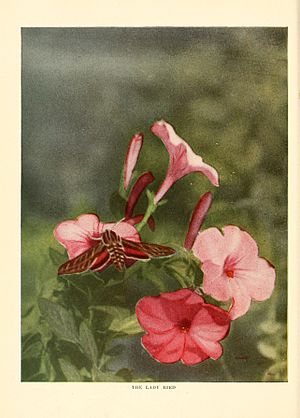Limberlost Swamp facts for kids
The Limberlost Swamp in the eastern part of the present-day U.S. state of Indiana was a large, nationally known wetlands region with streams that flowed into the Wabash River. It originally covered 13,000 acres (53 km²) of present-day Adams and Jay counties. Parts of it were known as the Loblolly Marsh, based on a word by local Native Americans for the sulphur smell of the marsh gas. The wetlands had mixed vegetation and supported a rich biodiversity, significant for local and migrating birds and insects, as well as other animals and life.
European Americans drained the Limberlost for agricultural development early in the 20th century, destroying the rich habitat. Since 1997, parts of it have been restored. Observers have documented a return of insects, birds, and wildlife of all sorts to the restored area of wetlands. Approximately 1,500 acres (6.1 km2) had been restored as of 2015. Several groups supported purchase of lands for what is now known as the Loblolly Marsh Nature Preserve, which was turned over to the state and is held by the Indiana Department of Natural Resources.
Origin of name
According to the History of Jay County by M.W. Montgomery, published in 1864, the name Limberlost came from the following event:
A man named James Miller, while hunting along the banks of the swamp, became lost. After various fruitless efforts to find his way home, in which he would always come around to the place of starting, he determined to go in a straight course, and so, every few rods he would blaze a tree. While doing this, he was found by friends. Being an agile man, he was known as 'limber Jim,' and, after this, the stream was called 'Limberlost.'
The Indiana State Museum contends, "The swamp received its name from the fate of 'Limber Jim' Corbus, who went hunting in the swamp and never returned. When the locals asked where Jim Corbus was, the familiar cry was 'Limber's lost!'"
Representation in media
- Indiana-born author Gene Stratton-Porter helped make the Limberlost Swamp famous in the early 20th century. She lived for years on its periphery and lobbied unsuccessfully against its ongoing destruction. The swamp served as the setting for two of her novels, Freckles (1904) and A Girl of the Limberlost (1909). Her novel The Harvester (1911) includes the names of many of the plants found in the swamp around the time the book was written. Stratton-Porter was also an accomplished artist and wildlife photographer who specialized in making close-up photographs of the birds and moths in their natural habitat. Several of her nonfiction nature books, including Moths of the Limberlost (1912), feature the swamp's wildlife. Her residences in the area became the laboratories for her research. They are preserved today as the Limberlost Cabin, the Limberlost State Historic Site in Geneva, and the Cabin at Wildflower Woods. The Indiana State Museum and Historic Sites operates Stratton-Porter's former homes as state historic sites, which are open to the public.
- Romance of the Limberlost (1938) is an American moving picture based on Stratton-Porter's writings and directed by William Nigh, and starring Jean Parker and Eric Linden. It is set in Indiana's Limberlost region in 1905.


